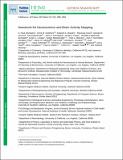Nanotools for Neuroscience and Brain Activity Mapping
Author(s)
Alivisatos, A. Paul; Andrews, Anne M.; Chun, Miyoung; Church, George M.; Deisseroth, Karl; Donoghue, John P.; Fraser, Scott E.; Lippincott-Schwartz, Jennifer; Looger, Loren L.; Masmanidis, Sotiris C.; McEuen, Paul L.; Nurmikko, Arto V.; Park, Hongkun; Peterka, Darcy S.; Reid, Clay; Roukes, Michael L.; Scherer, Axel; Schnitzer, Mark; Sejnowski, Terrence J.; Shepard, Kenneth L.; Tsao, Doris; Turrigiano, Gina; Weiss, Paul S.; Xu, Chris; Yuste, Rafael; Zhuang, Xiaowei; Boyden, Edward; ... Show more Show less
DownloadBoyden_Nanotools neuroscience.pdf (8.060Mb)
PUBLISHER_POLICY
Publisher Policy
Article is made available in accordance with the publisher's policy and may be subject to US copyright law. Please refer to the publisher's site for terms of use.
Terms of use
Metadata
Show full item recordAbstract
Neuroscience is at a crossroads. Great effort is being invested into deciphering specific neural interactions and circuits. At the same time, there exist few general theories or principles that explain brain function. We attribute this disparity, in part, to limitations in current methodologies. Traditional neurophysiological approaches record the activities of one neuron or a few neurons at a time. Neurochemical approaches focus on single neurotransmitters. Yet, there is an increasing realization that neural circuits operate at emergent levels, where the interactions between hundreds or thousands of neurons, utilizing multiple chemical transmitters, generate functional states. Brains function at the nanoscale, so tools to study brains must ultimately operate at this scale, as well. Nanoscience and nanotechnology are poised to provide a rich toolkit of novel methods to explore brain function by enabling simultaneous measurement and manipulation of activity of thousands or even millions of neurons. We and others refer to this goal as the Brain Activity Mapping Project. In this Nano Focus, we discuss how recent developments in nanoscale analysis tools and in the design and synthesis of nanomaterials have generated optical, electrical, and chemical methods that can readily be adapted for use in neuroscience. These approaches represent exciting areas of technical development and research. Moreover, unique opportunities exist for nanoscientists, nanotechnologists, and other physical scientists and engineers to contribute to tackling the challenging problems involved in understanding the fundamentals of brain function.
Date issued
2013-03Department
Massachusetts Institute of Technology. Department of Biological Engineering; Massachusetts Institute of Technology. Department of Brain and Cognitive Sciences; Massachusetts Institute of Technology. Media Laboratory; McGovern Institute for Brain Research at MIT; Program in Media Arts and Sciences (Massachusetts Institute of Technology)Journal
ACS Nano
Publisher
American Chemical Society
Citation
Alivisatos, A. Paul, Anne M. Andrews, Edward S. Boyden, Miyoung Chun, George M. Church, Karl Deisseroth, John P. Donoghue, et al. Nanotools for Neuroscience and Brain Activity Mapping. ACS Nano 7, no. 3 (March 26, 2013): 1850-1866.
Version: Author's final manuscript
ISSN
1936-0851
1936-086X